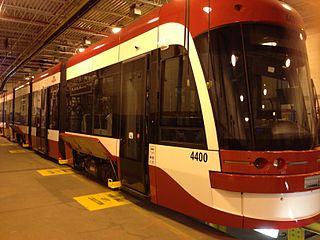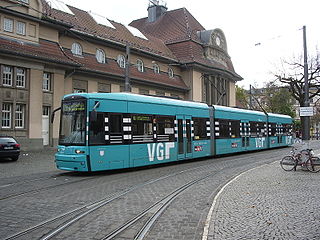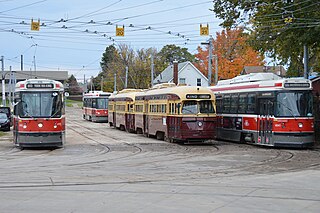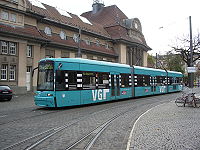
The Alstom Citadis is a family of low-floor trams and light rail vehicles built by Alstom. As of 2017, over 2,300 Citadis trams have been sold and 1,800 tramways are in revenue service throughout the world, with operations in all six inhabited continents. An evolution of Alstom's earlier TFS vehicle, most Citadis vehicles are made in Alstom's factories in La Rochelle, Reichshoffen and Valenciennes, France, and in Barcelona, Spain, and Annaba, Algeria.

The Siemens Avenio is a low floor tram family produced by Siemens Mobility, a subsidiary of the German conglomerate Siemens. It is the successor to the Combino family. The first generation was sold as the Combino Supra, Combino MkII, or Combino Plus. With the introduction of the second generation in 2009 the Combino brand was dropped and Siemens have referred to Combino Plus trams in Almada (Portugal) and Budapest (Hungary) as part of the Avenio range.

A low-floor tram is a tram that has no stairsteps between one or more entrances and part or all of the passenger cabin. The low-floor design improves the accessibility of the tram for the public, and also may provide larger windows and more airspace.

The Bombardier Flexity Swift is a series of urban and inter-urban tram, light rail and light metro vehicles manufactured by Bombardier Transportation. It is part of the Bombardier Flexity family of rail vehicles, and like the others, Flexity Swift vehicles can be customized to suit the needs and requirements of customers including legacy designs from its acquisition of Adtranz.

The Toronto streetcar system is a network of eleven streetcar routes in Toronto, Ontario, Canada, operated by the Toronto Transit Commission (TTC). It is the third busiest light-rail system in North America. The network is concentrated primarily in Downtown Toronto and in proximity to the city's waterfront. Much of the streetcar route network dates from the 19th century. Three streetcar routes operate in their own right-of-way, one in a partial right-of-way, and six operate on street trackage shared with vehicular traffic with streetcars stopping on demand at frequent stops like buses. Since 2019, the network has used low-floor streetcars, making it fully accessible.

The Bombardier Flexity Outlook is a series of low-floored, articulated light-rail trams manufactured by Bombardier Transportation. Part of the larger Bombardier Flexity product line, Flexity Outlook vehicles are modular in design and commonly used throughout Europe.
Bombardier Transportation was a Canadian-German rolling stock and rail transport manufacturer, with headquarters in Berlin, Germany. It was one of the world's largest companies in the rail vehicle and equipment manufacturing and servicing industry. Bombardier Transportation had many regional offices, production and development facilities worldwide. It produced a wide range of products including passenger rail vehicles, locomotives, bogies, propulsion and controls. In February 2020, the company had 36,000 employees, and 63 manufacturing and engineering locations around the world. Formerly a division of Bombardier Inc., the company was acquired by French manufacturer Alstom on 29 January 2021.

The Bombardier Flexity Classic is a model of light-rail tram manufactured by Bombardier Transportation. Although it is marketed as the most traditionally designed member of the Flexity family, it is still a modern bi-directional articulated tram with a low-floor section allowing good accessibility, especially to passengers in wheelchairs. Flexity Classic trams run on 1,435 mmstandard gauge in Australia, 1,000 mmmetre gauge in Essen, 1,450 mm in Dresden, and 1,458 mm in Leipzig.

The Socimi Eurotram (later sold as the Bombardier Flexity Outlook (E)) was an electric tramcar designed for the tram system of Compagnie de Transports Strasbourgeois (CTS). Initially produced by Socimi, after the company became bankrupt Eurotrams were manufactured first by ABB Group's transportation division, then by Adtranz and finally by Bombardier Transportation, who marketed the tram as part of their Flexity Outlook range.

The Siemens S70 and its successor, the Siemens S700, are a series of low-floor light-rail vehicles (LRV) and modern streetcars manufactured for the United States market by Siemens Mobility, a division of German conglomerate Siemens AG. The series also includes a European tram-train variant, the Siemens Avanto.

The Canadian Light Rail Vehicle (CLRV) and Articulated Light Rail Vehicle (ALRV) were types of streetcars used by the Toronto Transit Commission (TTC) from the late 1970s until the late 2010s. They were built following the TTC's decision to retain streetcar services in the 1970s, replacing the existing PCC streetcar fleet.

The Flexity 2 is a family of tram or light-rail vehicle manufactured by Bombardier Transportation. It is 100% low-floor, in order to easily accommodate wheelchairs and pushchairs. The trams are bi-directional, with cabs at both ends and doors on both sides, and are articulated with five or seven sections. This family of trams debuted on the Blackpool Tramway, England.

The Flexity Outlook is the latest model of streetcar in the rolling stock of the Toronto streetcar system owned by the Toronto Transit Commission (TTC). Based on the Bombardier Flexity, they were first ordered in 2009 and were built by Bombardier Transportation in Thunder Bay and Kingston, Ontario, with specific modifications for Toronto, such as unidirectional operation and the ability to operate on the unique broad Toronto gauge.

The Bombardier M5000, is a model of light rail passenger vehicle. It is part of the Flexity Swift range of vehicles, built specifically as a high-floor, articulated bi-directional tram to operate solely on the Manchester Metrolink system in England. The Metrolink system is the only tram network in the United Kingdom capable of running vehicles in multiple and subsequently the M5000s can operate as either a single vehicle or coupled together to form a "double" unit.
Inekon Trams, a.s. is a manufacturer of trams, or streetcars, located in the Czech Republic, and has supplied new trams to several cities in the Czech Republic and the United States. The company also carries out modernisation and repair of trams, as well as track reconstruction. It is a joint-stock company.
Tram Power is a Merseyside-based manufacturer of tramway vehicles. It built a single prototype, called the Citytram, which was tested on the Wirral Tramway and Blackpool Tramway from 2005 to 2007. The company is planning to build a tram line in Preston, Lancashire.

In 1921, the Toronto Transportation Commission (TTC) was created to integrate and operate the Toronto streetcar system. It inherited the infrastructure of two separate streetcar operators: the Toronto Railway Company (TRC) and Toronto Civic Railways (TCR). The TTC immediately embarked on a program to connect the TRC and TCR lines into one network. The TTC had to rebuild most of the track to provide a wider devilstrip so that the wider Peter Witt streetcars it was ordering could pass without sideswiping. Between 1938 and 1945, it placed five orders for air-electric PCC streetcars to replace the old, wooden streetcars of the TRC, and to address rising ridership. Between 1947 and 1951, the TTC placed three orders for all-electric PCC cars, with one order equipped with couplers for multiple-unit operation. Between 1950 and 1957, the TTC purchased PCCs from four American cities. By 1957, the TTC had more PCCs than any other city in North America. After the opening of the Bloor–Danforth subway in 1966, the TTC considered terminating all streetcar service in Toronto. However, in 1972, a citizens group led by Jane Jacobs and Steve Munro called "Streetcars for Toronto" persuaded the City to retain streetcar operation. This led to the development of the Canadian Light Rail Vehicle (CLRV) and its longer, articulated cousin, the Articulated Light Rail Vehicle (ALRV), to replace the aging PCC fleet. The Accessibility for Ontarians with Disabilities Act, 2005 (AODA) mandated that the next generation of streetcars be wheelchair-accessible. Thus, to replace the CLRVs and ALRVs, Bombardier adapted its low-floor Flexity Outlook model for the TTC to navigate the Toronto streetcar system's tight curves and single-point switches, characteristics set in 1921 to accommodate Peter Witt streetcars.

The Flexity Freedom is a low-floor, articulated light rail vehicle developed by Bombardier Transportation for the North American market. It is marketed as part of the Bombardier Flexity family which includes other models of trams (streetcars) and light metro vehicles. They are produced in facilities in Thunder Bay and Kingston, Ontario, which once produced rolling stock under the names of Canada Car and Foundry (CC&F) and Urban Transportation Development Corporation (UTDC), respectively.

The Alstom Citadis Spirit is a low-floor articulated light rail vehicle developed by Alstom for Ottawa's O-Train. It is marketed as part of its Citadis family, which includes other models of light rail vehicles, and is based on the Citadis Dualis.


























